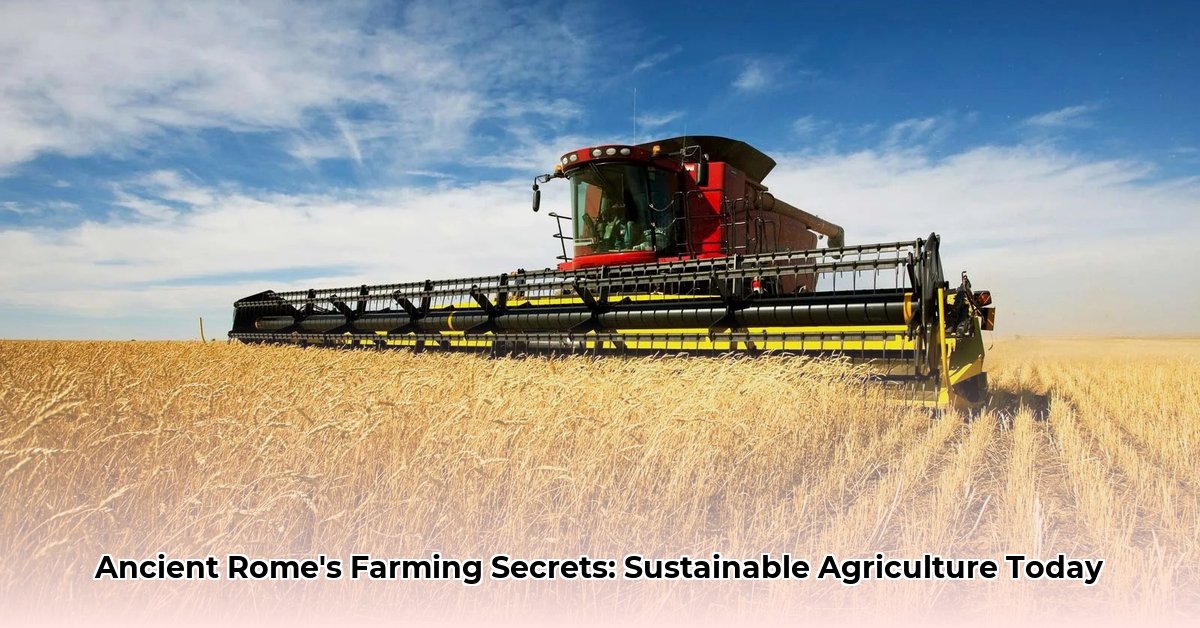Feeling stuck with today’s complex farming challenges? Soil fatigue, dwindling water reserves, and a heavy reliance on synthetic fertilizers often prompt a search for alternative solutions. What if the answers lay not in futuristic technology, but in the echoes of empires past? The ancient Romans, renowned for their intricate infrastructure and expansive reach, also cultivated sophisticated agricultural practices. Their methods, such as strategic crop rotation, ingenious water management, and the exclusive use of organic fertilizers, offer timeless lessons. By delving into Roman farming, we uncover a potential blueprint for a more sustainable agricultural future, preserving our planet while ensuring abundant food production. You can read more about the agriculture of ancient Rome.
Ancient Wisdom for Modern Farms: Unearthing Roman Agricultural Secrets
It might seem counterintuitive, but historical records can indeed illuminate pathways to a greener tomorrow. Let’s explore the agriculture of ancient Rome. Far from merely feeding a colossal empire, their farming methods indicate a surprisingly forward-thinking approach that holds actionable insights for contemporary agricultural dilemmas.
The Roman Roots of Soil Health: Nurturing the Earth
The Romans, without modern scientific instruments, intuitively grasped the importance of soil vitality. Their core secret for sustaining fertility was crop rotation. By systematically changing the type of crop planted in a field across seasons or years, they allowed the soil to naturally recover vital nutrients. This organic method regenerated the earth and naturally deterred pests and diseases, minimizing the need for external inputs. This approach not only enriched the soil but also significantly reduced the demand for chemical fertilizers, safeguarding the land for future harvests.
For instance, the cultivation of a triad of crops—cereals (like wheat, emmer, and spelt), olives, and grapes—was paramount within the Mediterranean climate. Roman agronomists such as Cato the Elder and Columella meticulously detailed these practices. Columella, in his work De re rustica, even noted emmer’s resistance to moisture and its various cultivated types. This focus on diverse crops within a rotation system, often including legumes like lentils, peas, and lupinus, maintained the soil’s structure and nutrient balance. Lupinus, in particular, was praised for requiring minimal labor, costing little, and serving as an excellent fertilizer for depleted lands.
For today’s cultivators, embracing such an approach means integrating practices like cover cropping (planting specific crops to protect and enhance soil quality) and intercropping (growing multiple crops simultaneously in one field). These techniques achieve the same ancient goals: maintaining robust, productive soil and fostering ecological balance.
Mastering Water: Roman Hydro-Engineering for Arid Lands
Imagine monumental aqueducts, appearing like constructed rivers spanning vast landscapes, delivering fresh water over considerable distances. The Romans were undoubtedly masters of water management, particularly in regions prone to drought. They meticulously engineered intricate irrigation systems to ensure that every drop was utilized effectively, thereby optimizing their available water resources.
Beyond the famous aqueducts, Roman farmers deployed sophisticated on-site water management. Cisterns collected rainwater, while channels and ditches distributed water efficiently across fields. In dry regions, innovations like the Archimedean screw allowed farmers to lift water from lower levels to higher ground, extending cultivation to areas with insufficient natural rainfall. Their deep understanding of local climate patterns informed crop selection; for example, they chose drought-resistant crops in arid zones and moisture-tolerant varieties in areas with higher rainfall.
Modern agriculturalists can mirror these sophisticated strategies. Drip irrigation, which precisely delivers water to plant roots, and rainwater harvesting, which collects and stores precipitation, are contemporary adaptations of ancient Roman ingenuity. These methods not only conserve precious water but also support more resilient farming operations, allowing for smarter, more efficient resource utilization.
Returning to Nature: The Power of Organic Fertilizers
Long before the advent of synthesized chemical compounds, Roman farmers depended entirely on nature’s bounty for enriching their crops. Manure and compost were their primary tools, recognizing the profound capacity of organic matter to nourish the land. By consistently enriching their fields with these natural fertilizers, they cultivated bountiful harvests season after season.
Roman agronomists, including Marcus Terentius Varro and Pliny the Elder, provided detailed insights into the efficacy of different organic materials. They understood that varying types of manure offered distinct benefits; for instance, poultry manure was considered the best, while cow manure was deemed one of the worst. Sheep and goat manure were also highly valued, and donkey manure was excellent for immediate use. Horse manure, though not ideal for grain crops, was recognized for promoting heavy growth in meadows. Ash from burned plant material also provided potassium and other trace elements, often mixed with manure or compost for enhanced effectiveness.
Today’s organic farming principles directly reflect these early, nature-centered methods. This involves renewing soil richness, minimizing chemical runoff into water systems, and fostering a healthier, more sustainable agricultural ecosystem. Such a strategy not only promotes robust crop health but also enhances biodiversity and significantly lessens environmental disruption.
Regional Specialization and Supply Chains: Lessons in Interdependence and Vulnerability
Roman farming was not monolithic; specific regions specialized in particular crops best suited to their local climate and terrain. While this specialization fostered efficiency, it also introduced vulnerabilities. For instance, Rome’s profound reliance on grain from Egypt and North Africa meant that local shortages due to drought or conflict could trigger widespread scarcity across the empire.
The Po Valley in northern Italy, for example, was renowned for its exceptional millet yields due to well-watered soil. Etruria, with its heavy soil, was good for wheat, while the volcanic soil of Campania was perfectly suited for wine production. Grain, supplying 70-80% of calories in the average Roman diet, was especially crucial. Major supply centers like Sicily, Egypt, and North Africa fed the massive urban population of Rome, which peaked at approximately one million people. Historian Josephus noted that by the 70s AD, Africa supplied Rome with grain for eight months of the year, and Egypt for four, a massive logistical undertaking known as the Cura Annonae. This reliance, however, made Rome vulnerable, as evidenced by the Egyptian crisis of 99 AD due to inadequate flooding.
This historical precedent serves as a powerful cautionary tale: over-dependence on international supply chains carries significant inherent risks. Cultivating and supporting community-based food systems is essential for enhancing stability and resilience in food security. Increasing local production not only reduces transportation emissions but also fortifies regional economies and ensures more secure food supplies, boosting community resilience against unexpected disruptions.
The Great Farm Debate: Sustainability Regardless of Scale
An ongoing scholarly debate exists regarding the predominant form of Roman agriculture: were vast estates (latifundia) more common, or did smaller, family-owned farms dominate the landscape? Early Rome saw small, self-sufficient landowners, but with the Republic’s expansion, latifundia—large estates owned by the wealthy and utilizing mostly slave labor—became increasingly prevalent. Cato the Elder, in his De agri cultura, even described a hypothetical 100-iugera farm with a specific slave workforce and equipment, though this was more of a political statement than a typical farm blueprint. Regardless of the answer, one truth remains clear: sustainable agricultural practices were indispensable, irrespective of farm size. Even the largest Roman estates required highly efficient soil management to maintain long-term productivity and ensure consistent yields.
The extensive reliance on slave labor, particularly on latifundia, enabled vast agricultural output, but also contributed to increasing economic inequality and social unrest. Cato’s detailed instructions on slave rations underscore the economic rather than humane treatment of this labor force. By the late Republic, many small landholdings were absorbed into these massive estates, influencing shifts in crops from grain to more profitable wine and olive oil.
This highlights that fundamental principles of sustainability—such as responsible land stewardship, efficient resource use, and diversified cultivation—apply universally, from the smallest plot to the largest operation. Modern sustainable agriculture actively champions fair labor practices and equitable access to land and resources. Initiatives such as Community-Supported Agriculture (CSA) programs, thriving farmers’ markets, and fair-trade certifications all strive to cultivate more equitable and just food systems, addressing the historical imbalances illuminated by Roman agricultural history.
Roman Agricultural Knowledge and Tools
Roman agricultural knowledge was meticulously preserved in detailed treatises by influential agronomists. Cato the Elder’s De Agri Cultura provided practical advice on estate management. Later authors like Varro, Columella, and Palladius expanded on these themes, discussing livestock, viticulture, and land use, reflecting not only technical expertise but also the cultural and economic significance of agriculture.
Roman farmers utilized a variety of tools, many of which were made of wood with iron tips, demonstrating simple yet effective engineering. The ard, a simple scratch plow, was essential for breaking up and aerating the soil. For harvesting, sickles were common, allowing precision cutting of grain stalks. The tribulum, a wooden board embedded with metal or stone fragments, was dragged over harvested grain to separate edible seeds from husks. For planting, hoes prepared the soil, and harrows were used to break up clumps after plowing.
One notable innovation was the “vallus” or “Gallic vallus,” an automatic harvester used in northern Gaul. This machine, pushed by oxen or horses, cut only the ears of grain without the straw. Though cumbersome and expensive, it represents an early attempt at mechanization. Mills, particularly water-powered ones like the impressive Barbegal complex in southern France, revolutionized grain processing, capable of producing 4.5 tons of flour per day to feed large urban populations. These tools and the systematic recording of agricultural practices contributed significantly to the efficiency and productivity of Roman farming.
Roman Aqueducts: Engineering the Flow of Life
Ever wondered how Roman aqueducts worked with such precision and longevity? These engineering marvels revolutionized ancient water management, profoundly impacting urban development and agricultural growth across the empire. Their success hinged on advanced engineering, durable materials, and meticulous maintenance, all converging to establish a reliable, gravity-fed water supply.
Precision and Materials: The Builders’ Toolkit
Roman engineers were master surveyors, employing sophisticated instruments to lay out these monumental structures. Tools like the groma (a surveying instrument used to establish right angles), the dioptra (a sighting device for measuring angles and elevations), the chorobates (a long straightedge with a water level for ensuring horizontal alignment), and the libra aquaria (another type of water level tool) enabled them to achieve precise angles and gradients. This precision allowed gravity to flawlessly direct water flow, effectively creating a super-long, gently sloping water channel.
They constructed these enduring structures using a combination of stone, brick, and opus caementicium (Roman concrete). This concrete, particularly potent when mixed with pozzolana (a natural volcanic ash that reacted with lime to create a hydraulic cement), became exceptionally durable, resisting decay for centuries. To ensure watertight integrity, they employed opus signinum (a waterproof mortar made from lime, sand, and crushed tiles), which sealed cracks and joints, effectively preventing leaks throughout the system.
Arches and vast arcades were strategically employed to support the immense weight of the water channel, especially when traversing valleys. The iconic Pont du Gard stands as a testament to this architectural and engineering prowess. Tunnels, when necessary, were often built using the “cut and cover” method, involving excavation, construction, and then backfilling, with vertical shafts providing essential access for construction and depth verification.
Impact and Ongoing Care: A Commitment to Public Welfare
The profound impact of aqueducts on agriculture was undeniable. A consistent and abundant water supply significantly improved irrigation capabilities, directly bolstering agricultural output and fostering both population growth and trade networks. Public fountains and thermal baths, generously supplied by these aqueducts, became central social hubs, dramatically elevating living standards in Roman cities by ensuring access to fresh, running water—a true game-changer for public hygiene and community life.
Maintaining these complex aqueducts was an arduous, continuous task. It involved features like settling basins to trap debris before water entered the main channels, strategically placed access shafts for regular cleaning, and the application of opus signinum for swift and effective repairs. This was far from a one-time construction; it was an ongoing commitment that demanded constant attention and skilled labor, highlighting the critical importance of expertise in maintaining such vital infrastructure systems.
Blueprint for Today: Implementing Roman Irrigation Principles
Roman engineers didn’t merely build aqueducts; they meticulously crafted water management systems that were foundational to the prosperity and longevity of entire civilizations. Their deep understanding of hydraulic principles and commitment to public welfare provides valuable lessons for addressing contemporary water challenges.
Strategy for Modern Water Systems: Adapting Ancient Ingenuity
How can we adapt Roman ingenuity to tackle today’s pressing water issues? Here’s a systematic approach, drawing direct inspiration from their methods:
- Integrate Ancient Design: Incorporate settling tanks, a Roman method for natural filtration, into modern water treatment facilities to enhance primary water quality by removing suspended solids and larger debris before advanced purification.
- Explore Groundwater Management: Adapt principles from Qanat systems (ancient underground aqueducts for tapping groundwater) for sustainable groundwater extraction in arid regions, reducing surface water dependency and minimizing evaporation.
- Enhance Infrastructure Resilience: Learn from Rome’s use of redundancy measures in their water supply systems to build more resilient and durable modern water infrastructure that can withstand disruptions caused by natural disasters or infrastructure failures.
- Employ Durable Materials: Study the composition and longevity of Roman concrete to develop more sustainable and enduring building materials for contemporary construction projects, potentially reducing maintenance needs and environmental impact.
- Apply Siphon Designs: Integrate siphon techniques, used by Romans to overcome topographic challenges, into today’s water supply networks for efficient and effective flow distribution over varied terrains without the need for additional pumping stations.
- Protect from Earthquakes: Analyze and apply earthquake-resistant features observed in ancient aqueducts to inform the design of new infrastructure in seismically active zones, enhancing safety and durability and protecting vital resources.
- Preserve Knowledge: Digitize the blueprints and structural details of ancient aqueducts to preserve their intellectual property and make them accessible for current and future study, fostering intergenerational learning and innovation.
- Educate the Public: Foster greater public understanding of the historical link between ancient water management and the pressing need for modern sustainable water practices, encouraging community engagement and support for conservation efforts.
- Support Interdisciplinary Studies: Promote research that integrates social, political, and technical insights from Roman water systems to inform and strengthen contemporary policy decisions regarding resource management, creating holistic and effective solutions.
Enduring Principles for Resilience: Balancing Innovation and Preservation
Maintaining ancient water systems was an intricate balancing act. Constant vigilance was required to prevent mineral deposits and address leaks, yet repairs themselves carried the risk of structural damage. This intrinsic dilemma underscores a fundamental principle: sustainable systems demand a careful equilibrium between ongoing maintenance and preserving structural integrity. This lesson remains profoundly relevant in modern infrastructure management, emphasizing the need for innovative solutions that respect existing structures while ensuring their long-term viability.
Roman aqueducts fundamentally improved public health and spurred urban expansion. They also showcased a profound comprehension of hydraulic principles, efficiently utilizing gravity to transport water across substantial distances. Modern urban planners and civil engineers can draw invaluable insights from this comprehensive, integrated approach to infrastructure development, demonstrating how historical wisdom can inform future design.
The Power of Proximity: Why Local Food Matters
Imagine ancient Rome’s rolling hills dotted with farms, a testament to agricultural systems shaped by the Mediterranean climate. Their economy and land management fundamentally rested on three staple crops: grains, olives, and grapes. What insights can these past practices offer for today’s sustainable agriculture movement?
The Romans also cultivated a diverse array of other crops beyond the staples, including millet, various legumes (peas, beans, chickpeas, lentils), root vegetables (turnips, parsnips, beets), leafy greens (cabbage, lettuce, celery), and a wide variety of herbs and fruits (figs, apricots, peaches, mulberries). This intentional variety provided a well-rounded diet and served as a crucial defense against the spread of pests and diseases. Even influential figures like Cato the Elder meticulously detailed ideal farm layouts that encouraged the integration of vineyards, gardens, and orchards, all designed to maintain the land’s long-term health. This emphasis on biodiversity is a core principle of modern agroecology, which advocates for resilient farming systems. Modern techniques such as polyculture (growing multiple crops in the same space), agroforestry (integrating trees and shrubs into agricultural landscapes), and intercropping directly echo the Roman approach to crop diversity, enhancing ecosystem services and significantly reducing the risk of widespread crop failure.
Actionable Paths to a Sustainable Future
The agriculture of ancient Rome offers invaluable lessons for contemporary sustainability efforts. Its core tenets—efficient water use, robust soil health, diverse crop cultivation, and consideration for local production—remain profoundly relevant as we strive to build a resilient and modern agricultural system. It is more than just history; it is a practical blueprint for the future.
Here’s a clear breakdown of actions various stakeholders can undertake, drawing inspiration from these ancient Roman practices:
| Stakeholders | Short-Term (0-1 Year) | Long-Term (3-5 Years) |
|---|---|---|
| Modern Farmers | Implement diversified crop rotation and organic fertilization; adopt precision water-saving methods like drip irrigation, which can help conserve water by almost double in most cases. | Explore resilient, climate-adapted crop options; collaborate on regional, lasting irrigation projects; actively restore and manage local water sources to increase availability and reduce reliance on distant supplies. |
| Policymakers (local and national government) | Offer targeted financial aid or subsidies to eco-friendly farms; support local community food programs to enhance access to quality, nutritious food for underserved communities. | Promote comprehensive land conservation and ecological restoration policies; invest in robust, smart water infrastructure that ensures safe and quality water sources are available for all citizens and agricultural use. |
| Consumers | Make a conscious effort to buy local, sustainably produced goods directly from farmers; actively reduce household food waste; consider the environmental impact of purchased products on global communities. | Demand transparent labeling from companies regarding sustainability practices and ethical sourcing; support businesses with strong environmental and social track records to encourage broader adoption of eco-friendly practices. |
| Research Institutions (Universities, Government Agencies, Private Companies) | Study ancient agricultural approaches proven successful, relating them to current sustainability plans; develop and rigorously test modern applications of historical techniques. | Share information on sustainable farming widely with the general public and farming communities via workshops and publications; collaborate with traditional knowledge holders and indigenous communities to explore innovative approaches to food production. |
| Urban Planners | Incorporate settling tanks into modern urban water treatment systems; evaluate Qanat-inspired methods for sustainable groundwater management in urban and peri-urban areas to reduce strain on surface water. | Develop integrated urban water management plans that prioritize resilience, water recycling, and efficiency; promote green infrastructure solutions that mimic natural water cycles for stormwater management and groundwater recharge. |
| Civil Engineers | Study Roman concrete compositions for developing more sustainable and durable building materials; integrate siphon designs for efficient urban water distribution; incorporate earthquake-resistant features into infrastructure planning in high-risk zones. | Design and implement large-scale water projects based on Roman hydraulic principles, focusing on durability, minimal environmental impact, and long-term functionality; innovate with self-healing concrete inspired by ancient Roman materials to extend infrastructure lifespan. |
| Historians/Archaeologists | Digitize aqueduct plans and related historical documents for preservation and accessibility; raise public awareness about the historical link between ancient water management and today’s sustainability needs. | Conduct interdisciplinary studies that blend social, political, and technical insights from ancient water systems to inform modern policy decisions; contribute historical data to climate change adaptation strategies by analyzing past societal responses to environmental challenges. |
The Roman agricultural legacy extends far beyond its political influence. It serves as a foundational market model that continues to inform modern actions. By integrating these historical insights with contemporary technology and values, we can build more resilient, equitable, and sustainable food systems for generations to come. So, what steps will you take to embrace this ancient wisdom for a more sustainable future?










